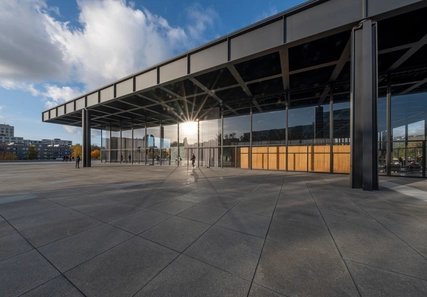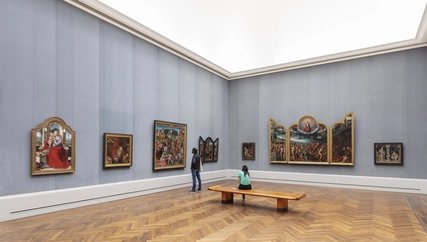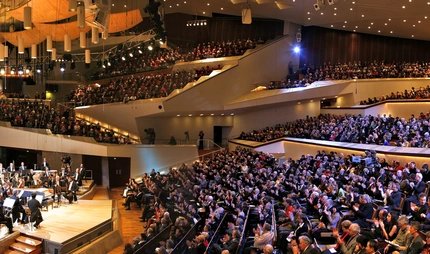
Kulturforum
Art, music, and science
This art and culture ensemble, which is not just architecturally diverse, lies between Potsdamer Platz and the Landwehr Canal.
The Kulturforum looks back on an extensive evolutionary and architectural history.
At the end of the 1950s, plans existed for a cultural axis across Berlin. They were based on the ideas of the architect Hans Scharoun, who was at that time president of the Akademie der Künste (Academy of Arts). The wall had not yet been built, and the axis was to extend from the Museum Island in the east to Charlottenburg Palace in the west.
The site of the present-day Kulturforum is located in Mitte. As a result of massive planning interventions during the Nazi era and the devastation of the Second World War, the area there lay fallow. A new cultural centre for a burgeoning post-war Berlin was to be built on it.
It was to provide visitors with the opportunity to enjoy art, listen to music, and study scientific writings in future. The impact of the individual institutes would be heightened by concentrating them on one spot – that was the plan.
Then came the building of the Berlin Wall and the Kulturforum, located close to the wall, became an important prestige project for the West. This not only meant it had to hold its own during the ongoing strife with the GDR regime, but also send a clear message to West Germany. The repatriation of the art and literature outsourced to the Federal Republic of Germany went anything but quickly. The construction of suitable buildings aimed to put pressure on bringing them back to West Berlin.
Everything takes time
A start was made in the 1960s and 1970s with three designs by two internationally renowned architects. The Philharmonie by Hans Scharoun marked the beginning of the construction activity at the Kulturforum. It celebrated its opening in 1963. Its unusual tent-like roof and yellow façade contrasted with the New National Gallery by Ludwig Mies van der Rohe, which opened five years later: a steel and glass architecture with its vast hall flooded with light.

The buildings made St. Matthew’s Church, which has been situated within the complex since the 19th century, seem somewhat antiquated. St. Matthäus-Kirche in the Kulturforum Berlin is a historical centre, a space for contemporary art and a religious place of peace for Berliners and Berlin visitors.
Scharoun's long-standing employee Edgar Wisniewski realised the Kammermusiksaal (Chamber Music Hall) and the Musikinstrumentenmuseum (Musical Instrument Museum) according to his plans. The Museum opened in 1984, and the Kammermusiksaal in 1987 to mark the 750th anniversary of the city of Berlin.
In the 1970s, the Staatsbibliothek was built on the other side of Potsdamer Strasse according to Scharoun's designs. It was opened in 1978, six years after the death of the architect. The neighbouring Ibero-American Institute was also based on one of Scharoun's designs.
The construction of the Staatsbibliothek devoured more money than originally estimated, which led to a delay in starting the construction of the other art houses planned.
Museum architecture in transition
West Berlin had already held an architectural competition in 1965 for the design of the entire Kulturforum. The expectations were high, and the most compelling design was to offer no less than a “structural characterisation of what a museum means for us today”.
In the eyes of the jury, no competitor would be able to achieve this ambitious goal. As a compromise, the responsible parties agreed to award the contract to the Stuttgart architect Rolf Gutbrod.
His designs dated back to a period in which the tasks and functions of museum architecture were questioned. What was the reciprocal relationship between the museums and the collections they housed? Which target groups were to be addressed?
The architect considered his designs to be an alternative to the classical and neo-baroque buildings on the Museum Island. His museums should not be intimidating but encourage people of all social strata to visit.
The Kunstgewerbemuseum (Museum of Decorative Arts) opened in 1985. Based on a 20-year-old design, the concept of the building with its brutalist façade and dominant stairwells had become outdated. And it wasn’t well received by the public: the criticism was so devastating, Gutbrod had to resign. It was initially unclear as to how things should proceed with the Kulturforum.
The Munich architects Heinz Hilmer and Christoph Sattler were awarded the contract to revise Gutbrod’s designs for the Kupferstichkabinett (Gallery of Prints and Drawings) and Kunstbibliothek. They changed numerous details and did away with the envisaged exposed concrete columns in the exhibition hall, for example.
The opening took place in 1994. With its façade clad in concrete and clinker brick, the building today is emphatically reserved.
The Gemäldegalerie was also the work of Hilmer and Sattler and opened in 1998. They needed to adapt their design because the location and entrance had been determined by Gutbrod. The architects abandoned prestigious façades and focussed on the quality of the interior design. Classically cut halls with perfect lighting conditions accentuated the precious collection.

The future of the Kulturforum
After six years of renovation, the Neue Nationalgalerie reopened its doors in August 2021. The magnificent collection of 20th century visual art has moved back in. In addition, there are exciting new exhibitions to see.
Another large museum is being built next to it: the berlin modern, Museum of the 20th Century.
The development of the open space between the Philharmonie and the Neue Nationalgalerie is intended to create a stronger spatial relationship between all the buildings.
The winning design of the competition comes from the Swiss architectural firm Herzog & De Meuron. The opening is scheduled for 2029. Here, further 20th century masterpieces from the collection of the National Gallery will be on display.
In the project "Utopia Cultural Forum", the residents of the Cultural Forum work together to explore the potential of the Cultural Forum with decentralised exhibitions, urban discussions and art actions and to make it visible to the general public.
Our tips for the Kulturforum
You can find even more culture in the Gropius Bau, which is within walking distance. Many galleries have opened close to the “Tagesspiegel” building on Potsdamer Strasse. You can also take a look at the future site of the Bauhaus Archive near Lützowplatz.
If you are interested in history, the Memorial and Information Centre for the Victims of the Nazi “Euthanasia” Murders (Gedenk- und Informationsort für die Opfer der nationalsozialistischen „Euthanasie“-Morde), the Memorial Centre for the German Resistance (Gedenkstätte Deutscher Widerstand), the Topography of Terror (Topographie des Terrors), and the German Spy Museum (Deutsches Spionagemuseum) are good starting points. The Kulturforum is part of the Historic Diplomatic Quarter, which you can explore by foot.
Practical information from visitBerlin
The Kulturforum at Potsdamer Platz is connected to the S- and U-Bahn network. Bus lines (M29, M48, 200) will take you from there to the City West, the historical city centre, and Alexanderplatz. To explore the city by public transport, we recommend the Berlin WelcomeCard. It can be supplemented with the museum pass of the National Museums in Berlin. Children and young people up to the age of 18 can enjoy free admission to many museums.



